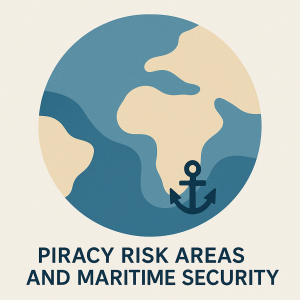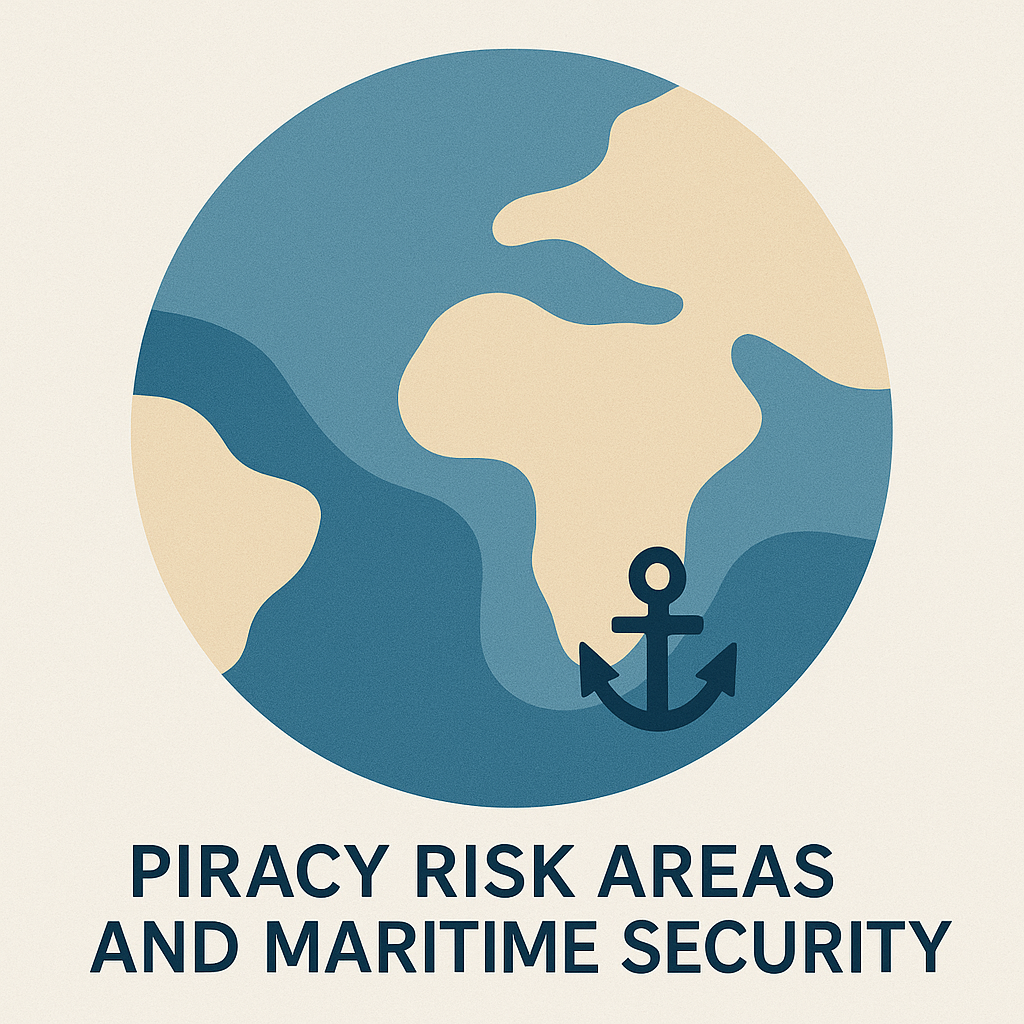Explore the world’s most dangerous piracy risk areas and the maritime security measures protecting global trade. Discover key hotspots, technological innovations, and real-world counter-piracy efforts in this comprehensive guide.
Why Piracy and Maritime Security Matter in Today’s Shipping Industry
 Imagine sailing through the Gulf of Aden—one of the world’s busiest maritime corridors. Suddenly, fast-moving skiffs appear on the radar, speeding toward your vessel. The crew goes into lockdown mode, the ship alters course, and an emergency alert is sent to naval authorities. For thousands of seafarers, this scenario isn’t fiction—it’s a lived reality.
Imagine sailing through the Gulf of Aden—one of the world’s busiest maritime corridors. Suddenly, fast-moving skiffs appear on the radar, speeding toward your vessel. The crew goes into lockdown mode, the ship alters course, and an emergency alert is sent to naval authorities. For thousands of seafarers, this scenario isn’t fiction—it’s a lived reality.
Modern piracy remains one of the most pressing threats to maritime safety, global supply chains, and seafarers’ lives. Despite advancements in ship design, automation, and naval surveillance, piracy has evolved, exploiting weak governance, economic instability, and porous coastlines.
According to the International Maritime Bureau (IMB), over 120 piracy incidents were reported in 2023 alone, with hotspots shifting due to regional conflicts, naval withdrawals, and changing criminal networks (IMB, 2024).
From Somali waters to West Africa, piracy is a geopolitical, economic, and human security challenge. This article explores the most dangerous regions, the evolving threats, and the international strategies safeguarding global maritime trade.
Major Piracy Risk Areas Around the Globe
Gulf of Guinea – West Africa’s Dangerous Waters
The Gulf of Guinea, stretching from Senegal to Angola, has emerged as one of the deadliest piracy zones. Unlike Somali piracy, which often targeted ship cargo or ransoms, West African pirates frequently kidnap seafarers for ransom.
The International Chamber of Shipping (ICS) reports that the Gulf of Guinea accounted for 95% of all crew kidnappings worldwide in 2020 (ICS, 2021).
Key factors driving piracy here include:
-
Weak maritime governance
-
High unemployment and poverty
-
Political instability in coastal states like Nigeria and Cameroon
-
Oil theft and illicit trade networks
Security responses include increased patrols by regional navies and initiatives like the Yaoundé Code of Conduct (2013)—a regional agreement to enhance information sharing and coordinated responses.
Gulf of Aden & Somali Basin – A Story of Decline and Resurgence
Piracy off Somalia’s coast dominated global headlines from 2008 to 2012. Ships like the Maersk Alabama and numerous oil tankers fell prey to armed pirates.
Thanks to international naval coalitions (e.g., EU NAVFOR Operation Atalanta, Combined Task Force 151) and the widespread use of Best Management Practices (BMP5), piracy incidents drastically declined. At the peak in 2011, 237 attacks were recorded. By 2022, none were reported (IMB, 2023).
However, in early 2024, a suspected hijacking occurred in the Somali Basin—a worrying sign of potential resurgence amid regional instability.
Singapore Strait – Piracy in Chokepoints
In contrast to hijackings or kidnappings, most incidents in the Singapore Strait involve petty theft and armed robbery. However, due to the high volume of vessels—over 1,000 daily—it poses a significant safety and navigation risk.
According to ReCAAP ISC, 107 incidents were reported in Southeast Asian waters in 2023, with the Singapore Strait accounting for 60% of them (ReCAAP ISC, 2024).
The region’s response includes:
-
Increased night-time patrolling by Singapore, Malaysia, and Indonesia
-
Coastal radar and VTS (Vessel Traffic Services) integration
-
Community awareness among fishermen and port workers
South China Sea – Tensions and Opportunism
While not a traditional piracy zone, parts of the South China Sea face maritime crime, including piracy, illegal fishing, and smuggling—often amid rising geopolitical tensions between regional powers.
Uncertainty over maritime boundaries adds a layer of risk for merchant vessels navigating these contested waters.
Technologies and Strategies Enhancing Maritime Security
Best Management Practices (BMP5)
The BMP5 guide, developed by industry associations (e.g., BIMCO, ICS, Intertanko), is a cornerstone of shipboard defense. It outlines risk assessment methods and passive defenses such as:
-
Razor wire and water cannons
-
Secure citadels for crew
-
Enhanced radar watchkeeping
-
AIS policy adjustments in high-risk areas
BMP5’s widespread adoption has been credited with deterring piracy attacks across multiple regions.
Naval Coalitions and Maritime Domain Awareness (MDA)
Global naval presence remains key. Multinational operations include:
-
EU NAVFOR Operation Atalanta in the Indian Ocean
-
CMF (Combined Maritime Forces) patrolling the Red Sea and Arabian Sea
-
Obangame Express in West Africa, backed by the U.S. Navy and AFRICOM
Maritime Domain Awareness uses satellite tracking, LRIT (Long-Range Identification and Tracking), and AIS data from platforms like MarineTraffic and Equasis to monitor high-risk zones in real time.
Autonomous Surveillance and AI
Recent innovations in maritime surveillance include:
-
Unmanned Aerial Vehicles (UAVs) for real-time video monitoring
-
Artificial Intelligence (AI) in anomaly detection (e.g., vessels switching off AIS or altering routes erratically)
-
Maritime security platforms like Thetius and Inmarsat’s Fleet Secure that offer predictive analytics and risk forecasting
Such tools empower fleet operators to make proactive decisions long before pirates approach.
Case Studies: Lessons from the High Seas
The MT Nave Andromeda Incident (UK, 2020)
A suspected hijacking was reported aboard the MT Nave Andromeda off the coast of the Isle of Wight. UK special forces intervened swiftly. Though the incident turned out to be a false alarm, it underscored how seriously maritime threats are treated—even in European waters.
MV Mozart Hijacking (Gulf of Guinea, 2021)
In a tragic attack, 15 crew members were kidnapped and one was killed aboard the Turkish vessel MV Mozart. The pirates traveled over 200 nautical miles offshore—highlighting their growing range and capabilities.
This incident pushed Turkey to increase naval escort missions for its flagged vessels, setting a precedent for flag-state accountability.
Challenges and Gaps in Maritime Security
Jurisdictional Hurdles
Piracy often occurs in international waters, complicating prosecution. The lack of a universal legal framework delays responses and trials. Although the UNCLOS defines piracy, actual jurisdiction often falls to flag states or coastal nations—many of which lack robust maritime law enforcement systems.
Underreporting
Fear of delays, insurance hikes, or bad publicity leads some shipowners to underreport incidents. The true extent of piracy may therefore be underestimated.
Crew Mental Health
According to research published in the WMU Journal of Maritime Affairs, repeated transit through piracy-prone areas contributes to long-term anxiety, PTSD, and depression among seafarers. Wellness programs like ISWAN’s SeafarerHelp have grown in importance.
The Future of Piracy and Global Maritime Security
Looking ahead, piracy will remain a shifting threat, influenced by:
-
Global conflicts (e.g., civil unrest in Sudan or Yemen)
-
Withdrawal of naval forces (e.g., EU NAVFOR scaled-down patrols)
-
Economic desperation in coastal communities
However, promising trends are also emerging:
-
Autonomous drones and smart buoys for early detection
-
Regional information fusion centers, such as the IFC Singapore, coordinating intelligence sharing
-
Cybersecurity protocols, ensuring bridge systems aren’t remotely compromised
New ship designs also emphasize hardened access control, engine-room fortifications, and autonomous emergency lockdown features—often inspired by lessons from past attacks.
Frequently Asked Questions
What is the most dangerous piracy area in 2025?
The Gulf of Guinea remains the highest-risk zone for crew kidnappings and armed attacks, though resurgence in Somali waters is under watch.
Is piracy still a problem today?
Yes, while the number of attacks has decreased globally, piracy persists in key hotspots, often with evolving tactics like cyber intrusion and offshore kidnappings.
How are ships protected from pirates?
Protection includes naval escorts, BMP5 practices, anti-boarding measures, citadels, and AI-based surveillance systems.
What is BMP5 in maritime security?
BMP5 (Best Management Practices) is a guide for ships transiting high-risk areas, offering procedures for threat detection and deterrence.
Do pirates still hijack large ships?
Yes, particularly in West Africa, where pirates use motherships and heavy weaponry to hijack tankers and cargo ships hundreds of miles offshore.
How can seafarers stay informed about piracy threats?
They can consult daily updates from IMB, ReCAAP ISC, Maritime Global Security, and the UKMTO advisory bulletins.
Who is responsible for counter-piracy operations?
Responsibility lies with naval coalitions, flag states, shipowners, and regional partnerships like the Yaoundé Architecture in West Africa.
Conclusion
Piracy isn’t just a relic of history—it’s a dynamic, evolving threat to modern maritime trade and human safety. While numbers have fluctuated, the danger remains real, particularly in regions with economic instability and weak governance.
However, thanks to proactive security protocols, multinational cooperation, and technological innovation, the industry is better prepared than ever. Yet, this preparedness requires constant vigilance, updated practices, and continued investment in seafarer training and welfare.
As global shipping becomes more automated and interconnected, the next era of maritime security may depend less on firepower and more on data intelligence, AI, and collaboration across borders.
Let us not wait for the next hijacking to remind us: maritime security is not optional—it is the cornerstone of safe global trade.
References
-
International Maritime Bureau. (2024). Annual Piracy Report. https://www.icc-ccs.org/index.php/piracy-reporting-centre
-
ReCAAP ISC. (2024). Annual Report on Piracy and Armed Robbery Against Ships in Asia. https://www.recaap.org
-
BIMCO. (2023). Best Management Practices (BMP5). https://www.bimco.org
-
ICS Shipping. (2021). Shipping and the Gulf of Guinea. https://www.ics-shipping.org
-
EU NAVFOR. (2023). Operation Atalanta. https://www.eunavfor.eu
-
Thetius. (2023). Cybersecurity in Maritime Operations. https://www.thetius.com
-
WMU Journal of Maritime Affairs. (2022). Mental Health and Security Risks for Seafarers.
-
MarineTraffic. (2024). Global Vessel Tracking. https://www.marinetraffic.com
-
Lloyd’s List Intelligence. (2023). Piracy Intelligence Reports. https://lloydslist.maritimeintelligence.informa.com
-
UNCTAD. (2023). Review of Maritime Transport. https://unctad.org


Thank youuu !